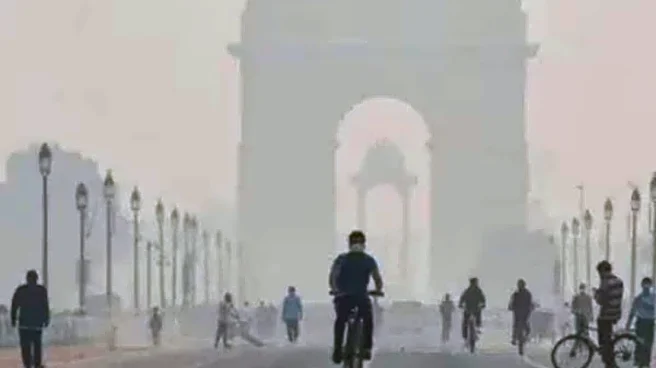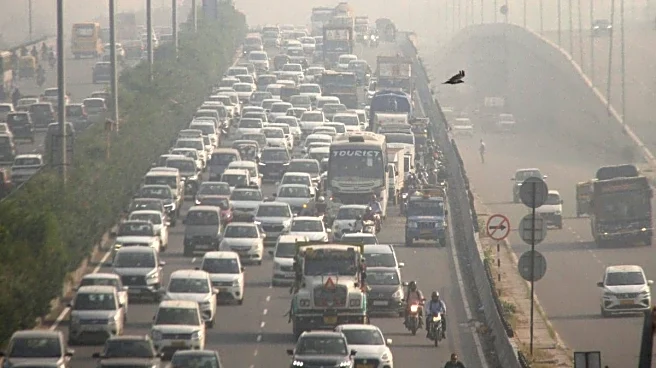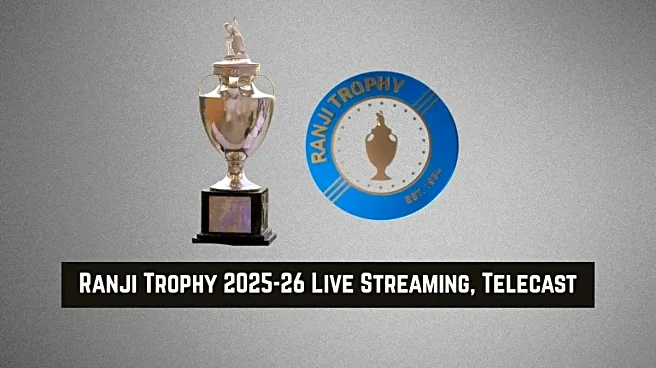Every year from October to January, the National Capital Region (NCR) experiences what has now become a familiar environmental emergency. The air turns acrid, visibility drops, and Delhi consistently ranks among the world’s most polluted cities. While weather conditions are a key factor, the seasonal spike in pollution is largely a man-made crisis layered over natural phenomena.
As temperatures fall, wind speeds slow and the mixing height of the atmosphere shrinks, trapping pollutants close to the ground. This is when the region’s multiple emission sources—vehicle exhaust, construction dust, industrial smoke, open waste burning, and seasonal stubble fires—combine to form the toxic haze.
The contribution of farm fires in Punjab and Haryana is particularly
pronounced between mid-October and November. Remote-sensing data from satellites, routinely cited by the Commission for Air Quality Management (CAQM) and SAFAR, detects thousands of stubble fires across the north-west plains during this period. In November 2023 alone, Punjab recorded over 36,000 such incidents.
Their smoke travels eastward into Delhi-NCR, where it mixes with local emissions, leading to days when air quality monitors record “severe” levels across the capital and its suburbs.
What Guardrails Exist To Manage The Crisis
In 2017, the government introduced the Graded Response Action Plan, or GRAP, to ensure a uniform response across NCR states when pollution levels spike. It was later revised under the supervision of the Commission for Air Quality Management, a statutory body created in 2021 to coordinate policies across Delhi, Haryana, Punjab, Uttar Pradesh, and Rajasthan.
GRAP prescribes a set of legally binding measures that are triggered automatically once the Air Quality Index crosses specific thresholds. These include restrictions on construction and demolition, bans on open waste burning, and limits on vehicular and industrial activity. At its most severe stage, the plan allows for school closures, truck bans, and work-from-home advisories.
In theory, these frameworks provide a ready-made mechanism for emergency response. In practice, however, implementation remains uneven. Agencies act only once the air turns visibly hazardous, and enforcement varies widely between districts. Many of the measures under GRAP are reactive rather than preventive, aimed at damage control rather than sustained improvement.
Beyond GRAP, the air quality regime rests on older legal pillars such as the Air (Prevention and Control of Pollution) Act of 1981 and the Environment Protection Act of 1986. Both empower pollution control boards to set emission standards and penalise violators. The Supreme Court and the National Green Tribunal have also issued a series of binding directions over the years, effectively filling gaps in executive action.
Punjab And Haryana’s Long Struggle With Stubble Burning
Punjab and Haryana’s role in the NCR’s winter smog has been contentious for over a decade. Both states have banned stubble burning under existing environmental laws, but enforcement has been sporadic. Farmers say the ban is impractical without viable alternatives, as clearing paddy residue manually or with machines takes time and money that small cultivators often cannot afford.
In 2022, Punjab reported over 71,000 fire events during the peak harvest window. In 2023, the number dropped slightly but still crossed 50,000. Haryana’s figures were lower but still significant, with around 8,500 stubble fire incidents recorded.
Successive governments in both states have announced subsidies for equipment such as Happy Seeders and in-situ straw management tools. Yet the uptake has remained limited, and each year tens of thousands of fires are recorded in Punjab alone. District officials are expected to impose fines or file cases against violators, but few such actions are taken on the ground.
The Supreme Court has repeatedly admonished the two state governments for what it calls administrative apathy. It has questioned why field officers fail to act, why pollution control boards remain understaffed, and why there is little accountability despite clear legal provisions. In one hearing last year, the Court noted that Punjab and Haryana could not continue to “pass the buck to wind direction” while Delhi choked.
Historically, Punjab has maintained that the pollution issue cannot be divorced from its agrarian economy. Shifting away from paddy to less water-intensive crops requires long-term incentives and federal support, which, it argues, have been slow to arrive. Haryana has taken a somewhat stricter line, claiming better compliance, but the difference has rarely been significant when the air turns grey over NCR.
Delhi’s Recurring Lapses And Quick Fixes
Delhi’s government often acts quickly with feel-good interventions during smog season, announcing odd-even traffic curbs, firecracker bans, and deploying smog guns or sprinklers. In recent years, over 300 water sprinklers (including tankers) have been deployed across Delhi roads to suppress dust, and anti-smog guns have been installed on dozens of government and private buildings. The 2025 air mitigation plan pushes this further, aiming for 1,000 sprinklers and 140 anti-smog guns citywide.
Yet, despite these visible measures, Delhi’s baseline emissions remain enormous. The city now hosts over 1.5 crore registered vehicles, nearly 13% of India’s total, and more than 7 lakh of these are diesel-powered. Construction activity continues round the year, often without adequate dust containment. Garbage burning remains common in unauthorised settlements, and major landfill sites like Bhalswa and Ghazipur have reported over 25 fire incidents combined in the last two years.
The capital also struggles with basic enforcement: a 2024 audit showed that less than 12% of vehicles flagged for pollution violations were actually penalised. Construction bans, even when announced under GRAP Stage III or IV, are often bypassed after dark. Because much of Delhi’s response is reactive and symbolic, changes seldom endure beyond the smog season.
The Supreme Court’s Evolving Stance
Few environmental issues have occupied India’s highest court as consistently as Delhi’s air. Since the 1980s, when the M.C. Mehta petitions led to the relocation of industries and the conversion of public transport to CNG, the Court has played a central role in forcing action that governments were unwilling or unable to take.
In recent years, its interventions have become more direct. The Court has held multiple winter hearings, summoning top bureaucrats from Punjab, Haryana, and Delhi. In October 2024, it criticised Punjab for failing to file even 100 FIRs despite 30,000 fire events. It also asked why nearly half of the Punjab Pollution Control Board’s enforcement posts remained vacant.
The bench observed that the problem had become one of “habitual negligence” and warned that token fines or advisories would no longer suffice. It asked for personal accountability from district magistrates and even hinted at contempt proceedings if orders continued to be ignored.
At the same time, the Court has acknowledged the limits of judicial oversight. It has repeatedly said that long-term solutions must come from executive policy, not courtroom supervision. Its role, as the bench noted during a 2023 hearing, is to “keep the system awake when it wants to sleep.”
Why The Cycle Persists Despite All Interventions
The persistence of NCR’s pollution problem reveals how fragmented environmental governance has become. Responsibility is spread across multiple states and dozens of agencies, each acting within its own jurisdiction. Political considerations also weigh heavily: punishing farmers risks unrest in Punjab and Haryana, while curbing construction or traffic in Delhi draws economic and electoral backlash.
The result is a cycle of delayed action and temporary relief. Each year, as the smog lifts by February, urgency fades until the next season returns. Even the CAQM, which was meant to ensure inter-state coordination, functions largely as a monitoring and advisory body with limited enforcement muscle.
Experts have long argued that the region needs structural reform rather than emergency control. That means diversifying crops in Punjab and Haryana to reduce stubble waste, strengthening public transport and electric mobility in Delhi, enforcing emission norms throughout the year, and giving pollution boards financial and administrative autonomy.
Until that happens, the same pattern is likely to repeat: rising AQI charts, short-lived restrictions, judicial reprimands, and a return to complacency once the wind changes.













/images/ppid_a911dc6a-image-17605897053038962.webp)


/images/ppid_a911dc6a-image-176051405896592746.webp)